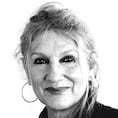‘Bristol is famous for three things,” said the gnomic man with the pink cheeks and sparkling eyes in the bed opposite my brother’s.
“Really?” I replied.
I was distracted: the tattooed nurse had gone off to have the prescription checked; there was a taxi, four floors below, waiting by the entrance to take us back to the flat; and my brother was insisting on walking out of the ward and through the labyrinthine corridors to get to it. He had a long, fresh scar running across his torso; I thought he might crack open.
“Yes indeed,” said the jolly man, moored to his hospital bed by tubes and wires. “Bristol is famous the world over for slavery, tobacco – and stools.”
He wasn’t taking about the kind of stools you pull up to a bar. The Bristol Stool Chart is used as an aid to faecal morphology (analysis of poo, in other words). It’s not unknown for playful medics to bake chocolate cakes for each other’s birthdays inspired by the seven shapes of shit identified on the chart.
Anyway. We made it to the taxi.
Bristol is a port city, its history entwined in transatlantic commerce, slavery being the most noxious and brutal of its imports and exports. It is an elegant place: the river cuts through it, the docks have been regenerated, tall ships and short craft bob about on the water, there are walkways and cafes and graceful buildings where you can buy delicate teas and shiny postcards of Banksy's street art, art that may have had its sting pulled since it nestled in the arms of catalogues and coffee-table books.
Pioneering treatment
My brother lives in Bristol. It is where his children were born. Recently he was the recipient of pioneering cancer treatment there. The city has become part of his DNA, and most certainly his DNA has become part of the city, not least the significant contribution he has made to the incinerator out the back of the Bristol Royal Infirmary.
I am the youngest of four. Between them, my three siblings have clocked up four different types of cancer. They are all still standing.
I experienced a surrealistic moment when my brother’s cancer was diagnosed. The scales tipped; I was now the only one of us not to meet the disease in person. Momentarily, I felt like I hadn’t been invited out to play.
My brother had navigated rough waters in his life before. He is a buoyant, seemingly indefatigable character, a writer, teacher and adventurer, but the picture was grim.
It probably sounds daft, but Bristol steadied us in that week my sister and I spent in the city after he left the gargantuan, pulsing hospital and retrieved his life. The city seemed to shoulder in and protect us, distract us, entertain us, with its diverse, playful culture.
My brother’s flat borders the self-proclaimed People’s Republic of Stokes Croft, which is really just one long road with a couple of dawdling streets on either side. On Jamaica Street there are shabby buildings that house artists’ studios and a pottery shop selling delicate porcelain decorated with irreverent images of the British royals (one appealing mug has a portrait of the queen below the words “I eat swans”). Next to the shop is an outdoor gallery, a long hoarding that is whited out every couple of months and repainted by a different artist.
Co-operative food stores abound in the area, alongside second-hand clothes stores and small junkshops selling chipped enamels and cloudy mirrors. A scarcity of Indian head masseuses is not one of the area's problems. There are eccentric bars stocked with bottles of craft beers, one of them with hooks along the ceiling to hang bicycles.
Notorious street battle
Once we ate in a local restaurant where the chef hid his dreadlocks under his toque, and the walls were decorated with plaster models of spleens and spines and dripping bandages. The food was comfortingly traditional.
A couple of years ago the residents of Stokes Croft fought a notorious street battle in a doomed stand against Tesco opening in their neighbourhood.
I was grateful for the republic’s hopeful edginess, for the temperate anarchy on those largely gentle streets.
My brother is well. His treatment, to coin a phrase, was at the absolute cutting edge of medical science. He’s now back teaching young writers and working on his third novel, this one about slavery and set in Ireland, Bristol and the Caribbean. The walls around his desk are covered in maps and charts and Post-it notes outlining the destinies of fictional characters who will live on in his pages.
His own story, in the city of slavery, tobacco, stools and much else, is ongoing.









